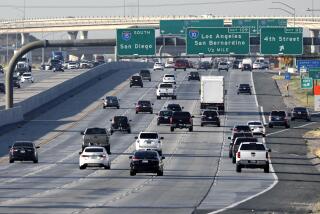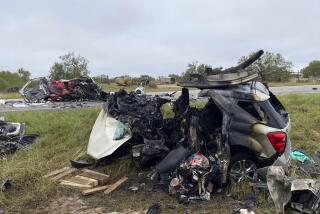‘No-Rules’ Motorists Drive Brazil to World’s Worst Safety Record
- Share via
RIO DE JANEIRO, Brazil — Race-car drivers arriving for Rio’s first Formula-Indy Grand Prix received a booklet with a warning: Beware of driving in Brazil. They didn’t take it lightly.
“I’ve never seen such dangerous traffic and lousy roads in my life,” said two-time Indy champion Bobby Rahal.
Brazilian veteran Emerson Fittipaldi agreed--he took a helicopter to the track.
This country has produced some of the world’s best race drivers, along with the worst safety record: 50,000 killed and 350,000 injured in traffic accidents each year.
By comparison, the United States has nearly 10 times more vehicles--198 million to Brazil’s 20 million--but just 41,000 traffic deaths a year.
“There are few laws, little enforcement, awful roads and drivers uneducated about the ABCs of traffic safety,” said Ulisses Iarochinsky, vice president of the National Traffic Safety Institute. “It seems the government simply doesn’t care.”
In the “no-rules” world of Brazilian driving, the 50-mph speed limit is widely ignored. Stoplights often are a matter of consensus--drivers routinely jump a red they consider “too long” or, at night, too risky because of muggers.
Driver courtesy can be taken as a sign of weakness or incompetence. Fights are common, and many motorists carry weapons.
“I’m tired of being sworn at on my way to work,” said civil servant Laudesi Torquato, brandishing a 3-foot lead pipe he carries in his car.
More than 50 million of Brazil’s 160 million people drive, and at least one-third of those motorists don’t have a legal license, Iarochinsky said.
Corrupt police and motor registries make it easy to get papers, and a lack of central controls makes detection haphazard. License plates can be ordered from the corner key-maker or knife sharpener.
“Some drivers don’t even use their headlights at night,” said Evan Sponagle, an American financial consultant who has lived in Rio for 25 years. “I had to stop driving defensively and adapt to the all-offense approach. You get bumped off the road if you’re in someone’s way.”
Traffic experts say it’s likely to get worse.
Since 1994, when inflation--and gasoline prices--were stabilized, the number of vehicles on Brazilian roads has climbed 30%. Mass transit is woefully inadequate: Greater Sao Paulo, for example, has only 27 miles of subway for a population of 16.5 million.
Drunkenness is a frequent cause of accidents, but drunk driving laws are rarely enforced. When they are, violators often get off with a slap on the wrist.
In one case, police charged real estate broker Luciano Ribeiro Pinto with being drunk and drugged in June 1992 when he ran a red light, jumped the curb and plowed into nine people on a sidewalk in Rio’s Copacabana beach district. Three were killed, including a mother and her 7-year-old son who had gone out to buy a school notebook.
Pinto was freed the same day on bail. When he finally went to trial earlier this year, he pleaded temporary insanity. His license was suspended and he was put in a mental hospital, where he is eligible for release after six months.
That sort of leniency could be changing. On May 28, Brazil’s Supreme Court upheld a murder conviction and a 10-year prison sentence for Jorge Bavaresco, who ran over and killed two people while racing with friends in a game called “catch.” It was the first time a driver had been convicted of anything more serious than manslaughter for a traffic fatality.
Last year, the government took other steps toward tightening traffic-safety rules and their enforcement, under a program called “Pare”--Portuguese for “Stop!”
Since mid-1995, seat-belt use has been mandatory in Rio and Sao Paulo, Brazil’s two biggest cities, but observance has been spotty at best. So the penalties have been raised sharply.
The fine for failing to buckle up now is the equivalent of $200--almost twice the monthly minimum wage. More than 6,000 drivers in Sao Paulo and 55,000 in Rio have been ticketed.
Congress also is debating new traffic laws that would raise the speed limit to 68 mph (110 kph) but also increase fines and jail terms for violations.
Still, even good drivers struggle on the country’s ill-kept roads. Of Brazil’s 840,000 miles of highways, only 9% are paved. And asphalt doesn’t last long under the tropical heat and the weight of trucks, which move 90% of the nation’s cargo.
Among the worst is Interstate Route 116 in southern Brazil. Potholes, poor signals and heavy traffic have caused so many accidents that it’s known as “The Highway of Death.”
Another is the 250-mile Presidente Dutra Highway between Rio and Sao Paulo. Highway patrolmen call it the “Swiss cheese” because of its many potholes.
President Fernando Henrique Cardoso has turned to the private sector for help.
In March, the Presidente Dutra Highway was leased to a conglomerate that will repair the road, install rest stops and clear away shrubbery obscuring signs. In exchange, the group can charge tolls, rent billboard space and exploit business-site leasing.
The 8-mile Rio-Niteroi bridge over Guanabara Bay also was privatized, and other roadways are to follow.
Cardoso also wants to repair Brazil’s dilapidated railways and attract foreign investors to build high-speed trams and subways as an alternative to cars.
More to Read
Sign up for Essential California
The most important California stories and recommendations in your inbox every morning.
You may occasionally receive promotional content from the Los Angeles Times.










